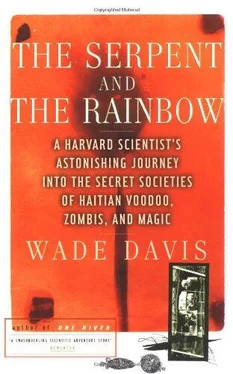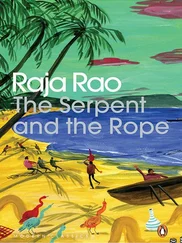Wade Davis - The Serpent and the Rainbow
Здесь есть возможность читать онлайн «Wade Davis - The Serpent and the Rainbow» весь текст электронной книги совершенно бесплатно (целиком полную версию без сокращений). В некоторых случаях можно слушать аудио, скачать через торрент в формате fb2 и присутствует краткое содержание. Год выпуска: 1985, Издательство: Simon & Schuster, Жанр: Старинная литература, на английском языке. Описание произведения, (предисловие) а так же отзывы посетителей доступны на портале библиотеки ЛибКат.
- Название:The Serpent and the Rainbow
- Автор:
- Издательство:Simon & Schuster
- Жанр:
- Год:1985
- ISBN:нет данных
- Рейтинг книги:5 / 5. Голосов: 1
-
Избранное:Добавить в избранное
- Отзывы:
-
Ваша оценка:
- 100
- 1
- 2
- 3
- 4
- 5
The Serpent and the Rainbow: краткое содержание, описание и аннотация
Предлагаем к чтению аннотацию, описание, краткое содержание или предисловие (зависит от того, что написал сам автор книги «The Serpent and the Rainbow»). Если вы не нашли необходимую информацию о книге — напишите в комментариях, мы постараемся отыскать её.
The Serpent and the Rainbow — читать онлайн бесплатно полную книгу (весь текст) целиком
Ниже представлен текст книги, разбитый по страницам. Система сохранения места последней прочитанной страницы, позволяет с удобством читать онлайн бесплатно книгу «The Serpent and the Rainbow», без необходимости каждый раз заново искать на чём Вы остановились. Поставьте закладку, и сможете в любой момент перейти на страницу, на которой закончили чтение.
Интервал:
Закладка:
What is potentially destructive in these psychological interpretations is their inherent assumption that possession is abnormal behavior, a premise that anthropologists, to their credit, have irrefutably debunked. One ethnological survey of some 488 societies around the world identified possession of some form in 360, and possession marked by trance was present in over half the total sample (including, incidentally, our own). From the Delphic oracles of ancient Greece to the shaman of northern Eurasia, possession by a spirit has been accepted as a normal phenomenon that occurs when and where appropriate, and usually within the context of religious worship. Yet even the conclusions of the anthropologists amount to observations, not explanations. They have accurately characterized the phenomenon as involving some kind of separation, transformation, and reintegration of diverse aspects of the human psyche. And, to be sure, they have been correct in noting that to some extent spirit possession is a culturally learned and reinforced response that has a therapeutic value as a spiritual catharsis.
Yet the central and disturbing questions remain. Why is it, for example, that the one possessed by the spirit in vodoun experiences total amnesia, yet still manifests the predictable and often complex behavior of the particular loa? For in Haiti, there is seldom any disagreement over the identities of the spirits. Legba is a weak old man, hobbling painfully and leaning on his crutch. Erzulie Freda is a queen, hopelessly demanding and vain. Ogoun has the warrior’s passion for fire and steel, usually brandishes a machete, and often handles glowing embers. And why is it that when Ogoun does pass the flames, the one possessed is not harmed? It was upon these unanswered questions that my logic wavered. There may, in fact, be a natural explanation for these extraordinary abilities, but if so it lies in regions of consciousness and mind/body interactions that Western psychiatry and medicine have scarcely begun to fathom. In the absence of a scientific explanation, and in the face of our own certain ignorance, it seems foolish to disregard the opinions of those who know possession best.
For most of the day, I sat near the base of the mapou. After weeks of constant travel and intermittent tension, it was good for once to remain still and simply watch, for I knew that things were about to change. Before long I was due to return to New York to report to Kline, and I didn’t know when, if ever, I would come back to Haiti. Evidently Kline was satisfied with the increased samples and now was most anxious to begin further laboratory investigations. From his perspective the initial phase of the project was complete: a pharmacologically active substance had been identified, which he could promote as the material basis of the zombi phenomenon. All that remained to accomplish as far as he was concerned was the documentation and medical study of a victim as it came out of the ground.
As yet another piece of evidence, the possibility of observing a legitimate graveyard ceremony intrigued me as much as anyone, and already I had begun to make discreet inquiries on Kline’s behalf. But from the start it struck me as something of a digression. The chances of success were slim, the risks were great, and moreover, even if the obvious ethical and practical difficulties could be surmounted, it would bring us no closer to what I saw as the core of the mystery. The evidence surrounding the case of Clairvius Narcisse was more than sufficient to crack the mirror of disbelief. Now for the first time the most important questions could be considered, and none of these could be answered by running all over Haiti looking for other zombis. We had the formula of the powder, and with the information provided by Herard Simon had been able to clear up a critical problem concerning the administration of the drug. From the disparate facts garnered from various informants, there was little doubt that Narcisse had suffered a form of voodoo death. But I still had not penetrated the belief system to know what the magic was, or what it had meant to Clairvius Narcisse.
The frontier of death. In Lehman’s first words to me he had identified the critical issue. A zombi sits on the cusp of death, and for all peoples death is the first teacher, the first pain, the edge beyond which life as we know it ends and wonder begins. Death’s essence is the severance from the mortal body of some elusive life-giving principle, and how a culture comes to understand or at least tolerate this inexorable separation to a great extent defines its mystical worldview. If zombis exist, the beliefs that mediate the phenomenon must be rooted in the very heart of the Haitian being. And to try to reach those places, to isolate the germ of the Haitian people, there was no better means than to spend a night and a day at Saut d’Eau filling my eyes with wonder, and listening to the words of the houngan.
For the Haitian, the ease with which the individual walks in and out of his spirit world is but a consequence of the remarkable dialogue that exists between man and the loa. The spirits are powerful and if offended can do great harm, but they are also predictable and if propitiated will gratefully provide all the benefits of health, fertility, and prosperity. But just as man must honor the spirits, so the loa are dependent on man, for the human body is their receptacle. Usually they arrive during a religious ceremony, ascending up the axis of the poteau mitan, called forth by the rhythm of the drums or the vibration of a bell. Once mounted, the person loses all consciousness and sense of self; he or she becomes the spirit, taking on its persona and powers. That, of course, is why the body of the possessed cannot be harmed.
But the human form is by no means just an empty vessel for the gods. Rather it is the critical and single locus where a number of sacred forces may converge, and within the overall vodoun quest for unity it is the fulcrum upon which harmony and balance may be finally achieved. The players in this drama are the basic components of man: the z’étoile , the gros bon ange , the ti bon ange , the n’âme , and the corps cadavre . The latter is the body itself, the flesh and the blood. The n’âme is the spirit of the flesh that allows each cell of the body to function. It is the residual presence of the n’âme, for example, that gives form to the corpse long after the clinical death of the body. The n’âme is a gift from God, which upon the death of the corps cadavre begins to pass slowly into the organisms of the soil; the gradual decomposition of the corpse is the result of this slow transferral of energy, a process that takes eighteen months to complete. Because of this, no coffin may be disturbed until it has been in the ground for that period of time.
The z’étoile is the one spiritual component that resides not in the body but in the sky. It is the individual’s star of destiny, and is viewed as a calabash that carries one’s hope and all the many ordered events for the next life of the soul, a blueprint that will be a function of the course of the previous lifetime. If the shooting star is bright, so shall be the future of the individual.
The two aspects of the vodoun soul, the ti bon ange and the gros bon ange, are best explained by a metaphor commonly used by the Haitians themselves. Sometimes when one stands in the late afternoon light the body casts a double shadow, a dark core and then a lighter penumbra, faint like the halo that sometimes surrounds the full moon. This ephemeral fringe is the ti bon ange—the “little good angel”—while the image at the center is the gros bon ange, the “big good angel.” The latter is the life force that all sentient beings share; it enters the individual at conception and functions only to keep the body alive. At clinical death, it returns immediately to God and once again becomes part of the great reservoir of energy that supports all life. But if the gros bon ange is undifferentiated energy, the ti bon ange is that part of the soul directly associated with the individual. As the gros bon ange provides each person with the power to act, it is the ti bon ange that molds the individual sentiments within each act. It is one’s aura, and the source of all personality, character, and willpower.
Читать дальшеИнтервал:
Закладка:
Похожие книги на «The Serpent and the Rainbow»
Представляем Вашему вниманию похожие книги на «The Serpent and the Rainbow» списком для выбора. Мы отобрали схожую по названию и смыслу литературу в надежде предоставить читателям больше вариантов отыскать новые, интересные, ещё непрочитанные произведения.
Обсуждение, отзывы о книге «The Serpent and the Rainbow» и просто собственные мнения читателей. Оставьте ваши комментарии, напишите, что Вы думаете о произведении, его смысле или главных героях. Укажите что конкретно понравилось, а что нет, и почему Вы так считаете.












